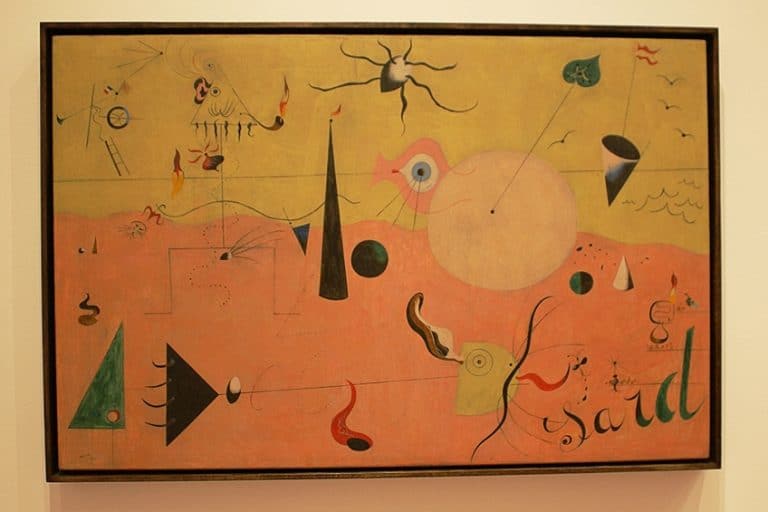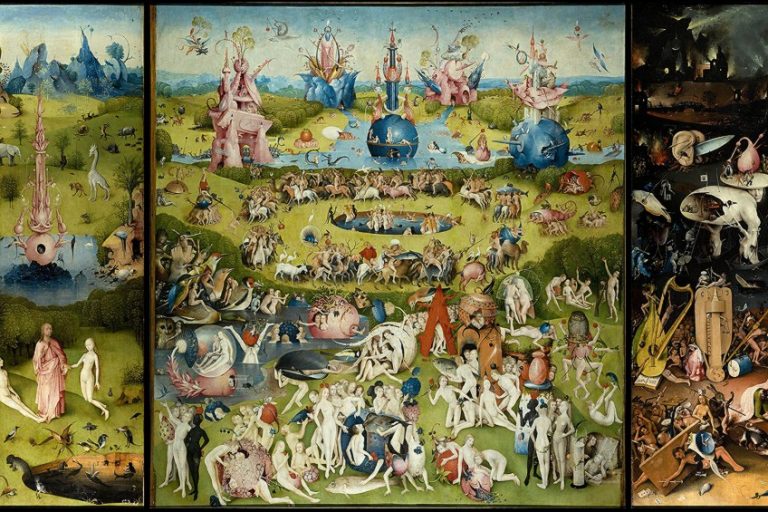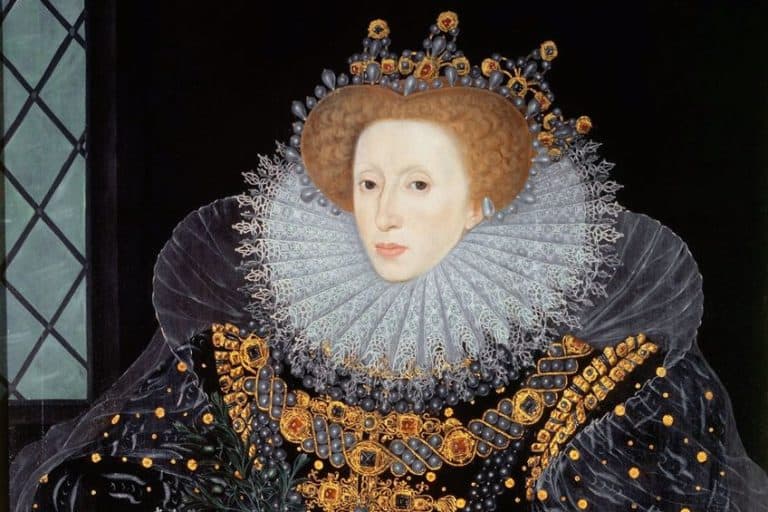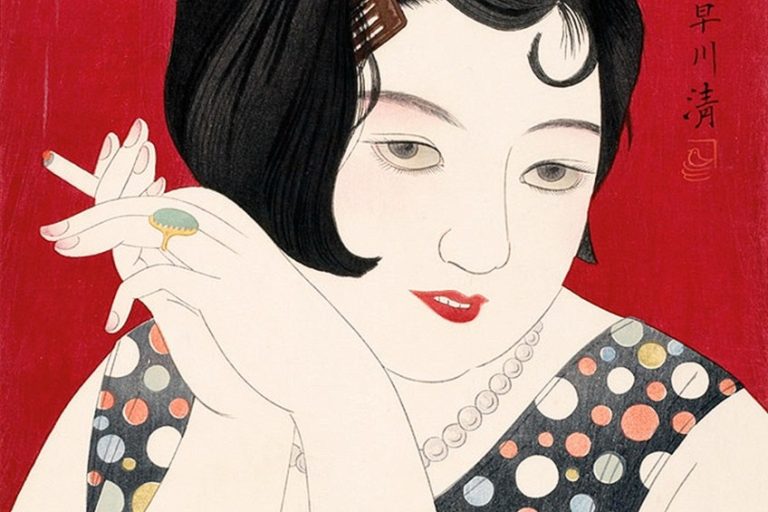“The Son of Man” Magritte – An Analysis of the Famous Apple Painting
A self-portrait with a twist – a man, the ocean, and a green apple – of course, we are talking about the famous apple painting The Son of Man (1964) by the Surrealist René Magritte. Although it might appear quite plain there is more than meets the eye, so to say. In this article, we explore this more famous Surrealism art piece and unpack The Son of Man meaning in more detail below.
Artist Abstract: Who Was René Magritte?
René Magritte was a Surrealist painter born in the city of Lessines in Belgium. He was born in November 1898 and had two other brothers; he was the eldest. Magritte studied at the Brussels Académie Royale des Beaux-Arts during 1916 to 1918. He moved to Paris in 1927 and became acquainted with the other Surrealist André Breton, who, among Surrealists, influenced his artistic style.
When he was a young boy, he reportedly saw his mother’s dead body pulled out of the water after she committed suicide; she had a covering over her face. However, the accuracy of the story has been debated. This experience could also explain part of Magritte’s artistic style. He died from cancer in 1967 when he was 86 years old.

The Son of Man by René Magritte in Context
In the article below we will discuss The Son of Man meaning. Starting with a contextual analysis, we will look at when René Magritte produced The Son of Man painting as well as the art movements that were prevalent during the time he painted, this was the Surrealist art period during the 1960s. We will explore the question: “Who is The Son of Man?”.
We will then discuss a formal analysis, having a closer look at the subject matter, including Magritte’s stylistic approaches like his color palette, the portrayal of light and shadow, perspective, and others.
| Artist | René Magritte |
| Date Painted | 1964 |
| Medium | Oil on canvas |
| Genre | Portrait painting (Self-portrait) |
| Period / Movement | Surrealism |
| Dimensions | 116 x 89 centimeters |
| Series / Versions | Part of two other paintings with a similar theme |
| Where Is It Housed? | Part of a private collection |
| What It Is Worth | Not available |
Contextual Analysis: A Brief Socio-Historical Overview
The Son of Man painting, or in French, Le fils de l’homme, is one of René Magritte’s most famous paintings, and more specifically, it is a self-portrait. It was commissioned by Magritte’s friend and attorney based in New York, Harry Torczyner. The two friends wrote letters to each other regularly.
In one of these correspondences, a letter from 1963 dated 28 June, Torczyner requested a self-portrait from Magritte. However, Magritte had some concerns about this request and felt that it raised a problem he was unsure of resolving, he also felt it was a “problem of conscience”.
He explained his concerns further in his response to Torczyner in a letter dated 2 July 1963, saying that he painted himself three times in a “picture” and that his intention for this was “to paint a picture, not to do a portrait.”
He continues: “I am able (or rather have been able) to paint a few portraits which were intended as such, but if the subject is myself, my visual appearance, this raises a problem that I am not sure of being able to resolve”.
Magritte further explained in the above letter that he will think about this request and try to find a solution to the problem. According to sources, he figured out what his best course of action would be for the self-portrait in April 1964, which was when he created The Taste of the Invisible (Le Goût de L’invisible) (1964).
The above was a gouache of the same subject matter we see in The Son of Man painting, however, apparently, Magritte drew inspiration from it and subsequently created Torczyner’s painting. He completed the painting in July 1964, this was when Torczyner reportedly visited Brussels.
The Son of Man painting is part of a series of similarly themed paintings wherein the central figures’ faces are also covered. All three paintings were created in the same year; the other two are titled The Great War on Facades (La Grande Guerre) (1964), where a woman stands with purple flowers covering her face, and Man In a Bowler Hat (1964), which depicts a dove in front of a man’s face, seemingly in mid-flight from right to left.
Recurring Motifs: Apples and Hats
Magritte had recurring and returning motifs in many of his paintings, in fact, these have become like identifiers of his artworks. Some of his recurring motifs include apples and bowler hats. These point to his viewpoints as well as plainly his style of clothing.
If we look at the object of apples, we see these in other paintings by Magritte, for example, The Listening Room (1952), The Postcard (1960), The Habit (1960), Le prêtre marié (“(1961), and Ceci n’est pas une pomme (“This is not an apple”) (1964).
As for the bowler hat, depicted in The Son of Man and other Magritte paintings, these refer to Magritte’s style. Apparently, the Surrealist artist dressed conservatively in similar hats and suits and explained in one of his interviews that “the bowler is a headdress that is not original: it poses no surprise. And I wear it. I am not eager to singularize myself. If I wanted to create a sensation in the street, I would dress for it. But I don’t want to”.
Although we see this commonly occurring motif that Magritte depicted from his own self and style the meaning could be that there is no meaning to it. It is merely a motif added to a painting and the artist leaves it up to us to decide what it should mean.
Magritte was known as having painted in the Impressionist style, a style he reportedly started in, including Cubism. He gradually developed his Surrealism style, and this became his signature René Magritte art style.
Magritte was influenced by the works of Giorgio de Chirico when he first started developing his Surrealist style. He utilized similar motifs from de Chirico’s artworks, and when Magritte lived in Paris, he also became acquainted with Surrealist artists like Salvador Dalí and Max Ernst. It is also noted that Magritte felt that the Surrealist subject matter became too “dark” and so he adjusted his stylistic approaches.
World War II also influenced Magritte’s style and he painted with the idea to incorporate a lighter feel in his art, and he is quoted as saying, “I now propose a search for joy and pleasure”, when he was talking about the “widespread pessimism” from the War and the Nazis.
Magritte’s other style that developed shortly after this was called “vache”, which means “cow” in French. This style was characterized by a wilder artistic approach from Magritte who combined unique color palettes and dynamic brushstrokes. From the variety of styles Magritte played with during his artistic career, one of his primary goals of painting was to question reality.
He left his paintings open for his viewers to contemplate and become aware of what is seen and not seen.
Formal Analysis: A Brief Compositional Overview
Below, we take a closer look at the man, the ocean, and the green apple. What is René Magritte depicting and how is he depicting it? There are details that we may not see straight away, so let us dive in.
Subject Matter
In The Son of Man, Magritte depicts a man standing facing us, the viewers, in the foreground. Both of his arms are at his sides, and we mostly see three-quarters of his body, primarily his upper torso. He appears quite rigid in his posture.
If we look even closer, we will notice his left arm (our right) is twisted in reverse, in other words, we see his left elbow. What we assume should be the anatomically correct side for us to see is faced towards the background.
He wears a dark gray overcoat with a white collared shirt and red tie underneath; on his head, he wears a bowler hat with what appears to be a light gray band. His overcoat has three buttons, but the third one is unbuttoned.
The man’s face is trickier to discern as there is a large green apple with around five leaves on its shoot covering most of the surface area of his face. All we can discern are hints of his eyes, especially his left eye, and the slight wrinkle lines on his skin around his mouth.
If we look at the background, we see a cloudy grayed sky and below it the hazy blue of what appears to be the ocean. It appears to be daytime, however, it is a cloudy day, and the clouds and ocean seem to melt into each other. There is light on the man, suggested by the darker area of shadow near the bottom right part of his coat, which appears black in shade.
The man stands with his back to this oceanic view, and we see part of a bordering sea wall, possibly stone, between him and this view. It is almost as if he is standing at a lookout point that we often see when visiting the ocean side. The horizon line is strongly delineated here, we see the line where the sky and ocean meet.
Color and Light
In The Son of Man Magritte utilizes colors to blend in and stand out. In the background, the dominant colors are blues and grays, cooler tones, which give the painting an ambiance of a seeming somberness. It also indicates a cloudy day, there is hardly any hint of sunlight, and it appears as if it may rain at any minute.
Magritte emphasizes this element of seriousness further by placing the main character in a gray suit, almost blending in with the grayness behind him. What is notable is how Magritte blended the distant horizon line where the sky meets the ocean, there is a smooth color transition and overall, the background appears soft in its application of color. There are hints of brighter colors in the foreground, which break our gaze on the gray. This is the red tie and the green apple, the only two colors that stand out from the monotones.
Although there are only two brighter colors, these add a hint of character as well as draw our attention to the central character.
Line
We notice a balance of horizontal and vertical lines, for example, the horizon line in the background, the horizontal lines from the sea wall just behind the central figure, and what appears to be a background divided into three horizontal sections: the sky, the ocean, and the wall.
The vertical lines break the horizontality of the composition; we see a strong vertical line in the central figure, especially the midline where his coat buttons up. However, there is an overall verticality from the figure himself and his two arms at his sides.
The apple appears to be the only rounded shape in the composition, echoed by the rounding of the bowler hat. There are slight diagonals from the figure’s collared shirt and coat collar. If we look at the painting it appears symmetrical in its composition.
The Son of Man Meaning
There have been a variety of interpretations trying to uncover The Son of Man meaning, some suggest religion, others conformity to society, hiding who you truly are, and as Magritte himself explains, the conflict that exists between the visible and hidden aspects.
Everyday Objects and the Visible and Hidden
Playing with the ideas of the visible and the hidden is one of the main themes in most of the René Magritte art collection. However, Magritte also uses everyday objects to twist our perceptions of what is real or not, and what is seen or not seen.
About The Son of Man Magritte explained that the apple is a “familiar object” utilized in his paintings, and with that, it starts to “pose questions” because our understanding of it is altered and “its mysterious quality has thus been evoked”.
When he explained further about the apple in front of the man’s face, he said “At least it partially hides the face. Well then, here we have the apparent visible, the apple, hiding the hidden visible, the person’s face”.
Magritte also stated that this “occurs endlessly” and “each thing we see hides another, we always want to see what is being hidden by what we see. There is an interest in what is hidden and what the visible does not show us. This interest can take the form of a fairly intense feeling, a kind of contest, I could say, between the hidden visible and apparent visible”.
Religious Meanings
Some sources also suggest that Magritte’s famous apple painting symbolizes Christian or religious ideas because of the title, The Son of Man. The figure could possibly be Jesus, who is the Son of Man and known as the Son of God from the Bible, however, the accuracy of this usage has been widely debated in Christian theology.
Another religious meaning could be that the apple is a symbol of temptation.
This is reminiscent of the Biblical story of Adam and Eve and the concept of the fall of man related to the story. Magritte is also remembered as having stated that his intention was not to have a religious meaning for the subject matter.
“The Stereotypical Faceless Businessman”
Another possible explanation for The Son of Man meaning is that it could allude to the idea of conformity and that people need to hide their real selves to fit into society. It has been suggested that the man with the suit symbolizes a “modern businessman” and he would adjust his identity to fit in with and meet the expectations of society.
The Son of Man With a Twist
Magritte’s The Son of Man was sold privately and have been on display on numerous occasions, for example, in 2001 it was in the lounge of the L’Hotel Montreal, and in 2018 it was on display at the San Francisco Museum of Modern Art, who borrowed it twice in 20 years according to the Curatorial Project Manager, Lily Pearsall.
However, it has become a rarity to view this famous apple painting in art galleries or museums, and it is a, somewhat, elusive work of art, slipping through the public’s gaze and grip.
There is hope for those of us who want our own copy of The Son of Man as it has been reproduced in multitudes of fashions and is available to purchase online as prints. The Son of Man painting is a pop-cultural icon as much as it is a famous Surrealism art icon. Other artists like Norman Rockwell created a reproduction called Mr. Apple (1970); the man has been given a red apple as a head and not a green apple in front of his face.

Other pop-cultural references are seen in television and music, for example, the famous Simpsons television series where the central characters of Bart and Homer Simpson stand similarly, only one has a lemon and one has a donut in front of their face. It has been in the Scream music video by Michael and Janet Jackson.
Other notable film references include the 1999 film The Thomas Crown Affair where it becomes a central object involved in thievery in an art gallery; the thieves also dress like the man we see in The Son of Man painting. What is notable here is that the main character’s romantic interest describes the painting as “the stereotypical faceless businessman”.
Although we are not able to view the real “Son of Man” by René Magritte, we can find it making an appearance in a variety of different media, from reproduced prints, reproduced versions by other artists, television, film, as well as music. While the real “Son of Man” will continue to thrive in a private collection it will always remain one of the best examples from the Surrealism art movement and from an artist who challenges us to see things just a little bit differently.
Frequently Asked Questions
What Is The Son of Man?
The Son of Man is an oil on canvas painting by the Surrealist artist René Magritte. It was painted in 1964.
Who Is The Son of Man?
The Son of Man is a biblical reference to Jesus Christ, although this is also the title of a painting by the Surrealist artist René Magritte. The artist painted The Son of Man in 1964, which depicts a man in a gray suit with a green apple floating in front of his face. Many speculate that this painting could be a religious reference and that the man is almost a symbol of Jesus Christ based on the title of the painting, however, this has been widely disputed and the artists reportedly mentioned he did not intend to depict any religious themes in his famous apple painting.
What Is The Son of Man Meaning?
There have been various theories around René Magritte’s painting The Son of Man and what it means. It is a painting open to numerous interpretations, although the explanation by Magritte himself gives us an idea of what the painting is about. Magritte stated that the painting touches on what we see and what we do not see, “the visible that is hidden and the visible that is present”. We see this in the positioning of the green apple in front of the man’s face, urging us to face what we see and what we cannot see.
Where Is The Son of Man?
The Son of Man painting has been sold to a private buyer and is now housed as a private collection, but it has been on display in some museums and hotels from time to time. It is a painting that has almost developed a reputation of being rare to view. There have been a significant number of reproductions of The Son of Man allowing the public and art enthusiasts to still have a copy of it.
Alicia du Plessis is a multidisciplinary writer. She completed her Bachelor of Arts degree, majoring in Art History and Classical Civilization, as well as two Honors, namely, in Art History and Education and Development, at the University of KwaZulu-Natal, South Africa. For her main Honors project in Art History, she explored perceptions of the San Bushmen’s identity and the concept of the “Other”. She has also looked at the use of photography in art and how it has been used to portray people’s lives.
Alicia’s other areas of interest in Art History include the process of writing about Art History and how to analyze paintings. Some of her favorite art movements include Impressionism and German Expressionism. She is yet to complete her Masters in Art History (she would like to do this abroad in Europe) having given it some time to first develop more professional experience with the interest to one day lecture it too.
Alicia has been working for artincontext.com since 2021 as an author and art history expert. She has specialized in painting analysis and is covering most of our painting analysis.
Learn more about Alicia du Plessis and the Art in Context Team.
Cite this Article
Alicia, du Plessis, ““The Son of Man” Magritte – An Analysis of the Famous Apple Painting.” Art in Context. January 13, 2022. URL: https://artincontext.org/the-son-of-man-magritte/
du Plessis, A. (2022, 13 January). “The Son of Man” Magritte – An Analysis of the Famous Apple Painting. Art in Context. https://artincontext.org/the-son-of-man-magritte/
du Plessis, Alicia. ““The Son of Man” Magritte – An Analysis of the Famous Apple Painting.” Art in Context, January 13, 2022. https://artincontext.org/the-son-of-man-magritte/.











